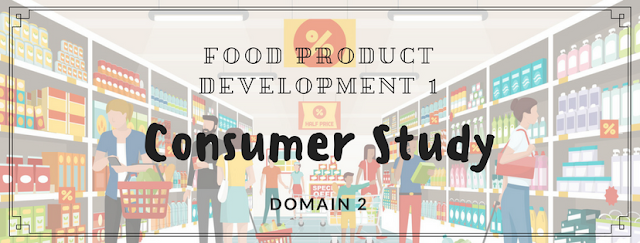Chapter 2: Dimensions of Food - Product Acceptability & Palatability
2.1 The important of sensory evaluation
What is sensory evaluation?
A scientific discipline used to evoke, measure, analyze and interpret reactions to the characteristics of food - perceived by 5 senses !
Why so important?
- sensory science is essential element of success in F&B development
- used the evaluation result to develop new products or maintain the quality control in existing food
- product reformation; product specification; product matching; shelf-life; quality; acceptability
In-House testing - by trained panelists; preliminary research; field testing & test marketing within the food company; provide guidance in food improvements.
2.2 Types of sensory tests & scorecards
Discrimination test: Determine whether or not a difference in some specific attribute exists between 2 samples; determine if one sample is preferred to another
1. Pair test: Determine whether 2 products different/identical;
- To determine which one more acceptable on a sensory dimension
2. Triangle test: Find out 2 similar among 3 samples or find 1 odd among 3 samples
- sample arrange random sequences across panelists
- as standard method for simple taint test
3. Duo-Trio test: Find out which one is more similar to standard/reference.
- To determine whether product differences result because of changes in ingredients/processing/ packaging/storage
- To determine whether an overall difference exists
Affective/Hedonic test: How much you like this product?
- Scaling method
- 9-point scale - widely used for food acceptability
- Eight-point scale - Usually for meat product evaluation
- Ten-point product quality scale - from excellent-to-poor
- “The face” / “smiley” scale (with one extreme with a frowning smiley face and anchored at the other extreme with a happy smiley face) - for children
Descriptive test: quantitative descriptions for products based on perceptions from trained panelists. (example: Quantitative Descriptive Analysis, QDA)
2.3 Sample preparation & presentation
Sample size - How many panelists needed? (it depends on the sensory method)
Sensory lab environment - should keep quiet and odorless; food preparation should not done in the testing area.
Sample presentation - size of sample(not too big), location, marking of sample(random numbers)
2.4 Sensory characteristic of food
What is sensory evaluation?
A scientific discipline used to evoke, measure, analyze and interpret reactions to the characteristics of food - perceived by 5 senses !
Why so important?
- sensory science is essential element of success in F&B development
- used the evaluation result to develop new products or maintain the quality control in existing food
- product reformation; product specification; product matching; shelf-life; quality; acceptability
In-House testing - by trained panelists; preliminary research; field testing & test marketing within the food company; provide guidance in food improvements.
2.2 Types of sensory tests & scorecards
Discrimination test: Determine whether or not a difference in some specific attribute exists between 2 samples; determine if one sample is preferred to another
1. Pair test: Determine whether 2 products different/identical;
- To determine which one more acceptable on a sensory dimension
 |
| Pair test scorecard |
2. Triangle test: Find out 2 similar among 3 samples or find 1 odd among 3 samples
- sample arrange random sequences across panelists
- as standard method for simple taint test
 |
| Triangle test scorecard |
3. Duo-Trio test: Find out which one is more similar to standard/reference.
- To determine whether product differences result because of changes in ingredients/processing/ packaging/storage
- To determine whether an overall difference exists
 |
| Duo-Trio test scorecard |
Affective/Hedonic test: How much you like this product?
- Scaling method
- 9-point scale - widely used for food acceptability
- Eight-point scale - Usually for meat product evaluation
- Ten-point product quality scale - from excellent-to-poor
- “The face” / “smiley” scale (with one extreme with a frowning smiley face and anchored at the other extreme with a happy smiley face) - for children
Descriptive test: quantitative descriptions for products based on perceptions from trained panelists. (example: Quantitative Descriptive Analysis, QDA)
2.3 Sample preparation & presentation
Sample size - How many panelists needed? (it depends on the sensory method)
Sensory lab environment - should keep quiet and odorless; food preparation should not done in the testing area.
Sample presentation - size of sample(not too big), location, marking of sample(random numbers)
 |
| Pair Test Presentation |
 |
| Duo-Trio test presentation |
 |
| Triangle test presentation |
- Refer to the attributes of food that need for sensory evaluation
- To gain knowledge of human perception of the food
Attributes including appearance,texture,flavor and aroma.
Appearance - color or surface characteristic
Texture - Stickiness, crispiness, crunchiness, moistness, tenderness, chewiness, grainy = MOUTHFEELS!
Flavor - the taste and intensity of flavor in the mouth; Ideal Temperature = 20 to 30 degree Celsius






Comments
Post a Comment